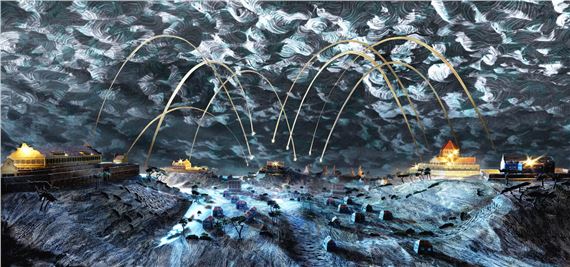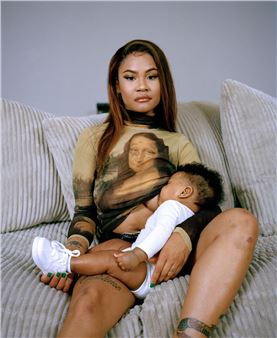Jasper de Beijer: The AdmiralвҖҷs Headache
The Rijksmuseum, the NetherlandsвҖҷs national museum of art and history, is opening a major slavery exhibition spanning four continents and three centuries. 4 Curators have been working on this sensitive important part of the Dutch past: Eveline Sint Nicolaas, Valika Smeulders, Maria Holtrop and Stephanie Archangel. Because during colonial slavery, millions of people were reduced to merely вҖҡobjectsвҖҷ (the possession of another), the exhibition is on purpose focussing on the lives of 10 persons; closely and personally we will be introduced to the smallest of details that hide the largest of pain.
For Dutch artist Jasper de Beijer the alienated idea of colonialism has been incredibly closely knit within his oeuvre. вҖһEver since he graduated at the Royal Academy of Art The Hague, Jasper de Beijer has been concerned with the question of representation, with the image as an essential element in the construction of history and as a vector for mythology and clichГ©вҖқ, writes curator RaphaГ«lle Stopin in Jeu de Paume, Magazine. In for example his series Buitenpost (Dutch East Indies), The Devil Drives (based on the narration by the explorer Richard Burton in the 1860s in Africa) or The Riveted Kingdom (evoking the great age of industrial invention in United Kingdom), De Beijer choose subjects for its strong visual mythology, be it that of the colonial farmer, the white explorer or the Japanese warrior. Every time De Beijer, who mixes photography, drawing, digital drawings and sculpture, loves to respond in his works on how we (media and society) maintain a sort of colonial age with its romantic clichГ©s.
One of his most recent works comes from his series вҖҳThe AdmiralвҖҷs HeadacheвҖҷ. Doing research on CuraГ§ao in 2019, De Beijer was startled how meticulously mechanised the Dutch colonial system operated in order to impose order and profit. Remnants of Dutch 17th century architecture of the Dutch, still standing on landmark sites, show off their bright colours. The architecture is of a typical Dutch mansion, like ornamented bunkers overseeing the former plantations, where the African people held in slavery were working. вҖңThe interior of these CuraГ§ao-mansions were a copy of typical Dutch farm interiors; as if they locked up the Dutch culture inside the walls, like a cultural hub or cocoonвҖқ, says De Beijer. De Beijer imagined the whole colonial system as an alien invasion on the island. In the final images of вҖҳThe Admiral HeadacheвҖҷ the colonialists become hidden players, only present behind their facades, their empty uniform costumes in the museums in CuraГ§ao or the Dutch forts attacking invisible ships of different European origin.

The Rijksmuseum, the NetherlandsвҖҷs national museum of art and history, is opening a major slavery exhibition spanning four continents and three centuries. 4 Curators have been working on this sensitive important part of the Dutch past: Eveline Sint Nicolaas, Valika Smeulders, Maria Holtrop and Stephanie Archangel. Because during colonial slavery, millions of people were reduced to merely вҖҡobjectsвҖҷ (the possession of another), the exhibition is on purpose focussing on the lives of 10 persons; closely and personally we will be introduced to the smallest of details that hide the largest of pain.
For Dutch artist Jasper de Beijer the alienated idea of colonialism has been incredibly closely knit within his oeuvre. вҖһEver since he graduated at the Royal Academy of Art The Hague, Jasper de Beijer has been concerned with the question of representation, with the image as an essential element in the construction of history and as a vector for mythology and clichГ©вҖқ, writes curator RaphaГ«lle Stopin in Jeu de Paume, Magazine. In for example his series Buitenpost (Dutch East Indies), The Devil Drives (based on the narration by the explorer Richard Burton in the 1860s in Africa) or The Riveted Kingdom (evoking the great age of industrial invention in United Kingdom), De Beijer choose subjects for its strong visual mythology, be it that of the colonial farmer, the white explorer or the Japanese warrior. Every time De Beijer, who mixes photography, drawing, digital drawings and sculpture, loves to respond in his works on how we (media and society) maintain a sort of colonial age with its romantic clichГ©s.
One of his most recent works comes from his series вҖҳThe AdmiralвҖҷs HeadacheвҖҷ. Doing research on CuraГ§ao in 2019, De Beijer was startled how meticulously mechanised the Dutch colonial system operated in order to impose order and profit. Remnants of Dutch 17th century architecture of the Dutch, still standing on landmark sites, show off their bright colours. The architecture is of a typical Dutch mansion, like ornamented bunkers overseeing the former plantations, where the African people held in slavery were working. вҖңThe interior of these CuraГ§ao-mansions were a copy of typical Dutch farm interiors; as if they locked up the Dutch culture inside the walls, like a cultural hub or cocoonвҖқ, says De Beijer. De Beijer imagined the whole colonial system as an alien invasion on the island. In the final images of вҖҳThe Admiral HeadacheвҖҷ the colonialists become hidden players, only present behind their facades, their empty uniform costumes in the museums in CuraГ§ao or the Dutch forts attacking invisible ships of different European origin.
Artists on show
Contact details


 ARTISTS
ARTISTS










